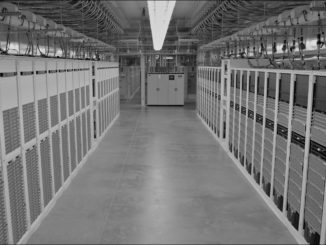
Hewlett Packard Enterprise in January created its Transformation Office with an eye toward accelerating its move to become a platform provider – complete with hardware, software, services and other components – with a reach from the datacenter out through the cloud and to the fast-growing edge computing environment. This was less than a year after CEO Antonio Neri told the thousands of attendees at the Discover 2019 event that the company by 2022 would be offering its entire portfolio as a service, with its GreenLake cloud-like IT-as-a-service platform as a foundational element of those plans.
Four months later in May, HPE announced a broad reorganization of the vendor to accelerate the transformation to a services- and solutions-focused company that included the creation of a cloud services unit based on GreenLake and headed up by Keith White, a 25-year veteran of Microsoft who spent years working on the company’s Azure public cloud and was given the task of giving HPE enterprise customers a consistent cloud experience regardless of where their applications and data lived, whether it was in the datacenter, in public or private clouds or at the edge.
There also were a host of other moves, including creating an HPC and Mission Critical Solutions unit headed by Peter Ungaro, the former CEO of supercomputer maker Cray, which HPE bought last year for $1.3 billion, and the Intelligent Edge group, led by Keerti Melkote, ex-CEO of Aruba Networks, the wireless networking vendor picked up by HPE in 2015 for $3 billion. Neri also appointed Kumar Sreekanti – a one-time VMware executive and founder and CEO of BlueData, an artificial intelligence and big data company scooped by HPE in 2018 – as CTO and head of the company’s Software unit.
They were the latest steps by a company that was born out of change and transformation, created when IT stalwart Hewlett-Packard split in half in 2015, creating HPE and PC and printer maker HP Inc. Since taking over as CEO in 2017, Neri has been focused on the idea that enterprises will continue to live in a world of datacenters, clouds and edges, and that HPE needs to become a company that can provide enterprises with the technology to have a seamless experience throughout their entire IT environments. In 2018, Neri said the company would invest $4 billion over four years in developing technology for the edge, an effort he told journalists this week on schedule despite the economic fallout from the global COVID-19 pandemic.
It’s not unlike the changes many of HPE’s peers – from Dell and Cisco to IBM, Lenovo and others – are going through. The IT world is becoming more data-centric, more distributed and more software- and services-focused. Where for decades the focus was on the hardware – servers, storage, networking and the like – housed in datacenters that ran and stored an organizations data and software, now systems are vehicles for running and storing the data and applications wherever they are. Vendors are working to adapt to this rapidly evolving world. As Sreekanti told The Next Platform in an interview, “Sometimes you can just ask, are we becoming a software company? No, we’re becoming a solutions company. … Think of HP as a software company, but we also know we are a strong brand in GreenLake and GreenLake is an opportunity for customers to bring the computer where the data is and not take the data to the computer.”
John Schultz, who heads up HPE’s Transformation Office, said during a press briefing this week that the office was launched with the “expressed mission of accelerating the company’s pivot to be the edge-to-cloud platform-as-a-service company. The Transformation Office is a core team with expertise that has been assembled from across the company to drive that customer experience that we all believe will be unique and differentiating for HPE and solve our customers’ problems. Our fundamental purpose is all about delivering cloud services.”
At its virtual Discover 2020 even this week, the company again put most of the focus on GreenLake and its software business. With GreenLake, the company is significantly expanding its reach, offering more than a dozen new cloud services that touch on everything from containers, virtual machines and MLOps to storage, compute, networking and data protection, creating a more cloud-like platform complete with a marketplace of services that can run in any environment and be managed via GreenLake. There also are hardware-software building blocks that can be configured in different sizes – small, medium and large – preconfigured and delivered in 14 days for less. A new self-service platform enables enterprises to easily choose and deploy the services they want.
Bringing such cloud capabilities on premises will continue to be important to enterprises into the future, White said during press briefing before the event. Only about 30 percent of workloads are in the private cloud; the rest are still sitting in corporate datacenters for any number of reasons, from the data that resides in them to worries about latency, security and regulatory compliance. With the expanded services via GreenLake, those workloads can be run in a cloud-like fashion and managed with GreenLake.
HPE is seeing good adoption of GreenLake since its introduction in 2018. More than 800 customers are using the platform and there were about 250 early adopters of GreenLake Central, first raised late last year as a software platform with an operations console that enables enterprises to manage applications and data throughout their entire cloud operations, from hybrid, public and private clouds and out to the edge.
HPE also rolled its software into a new portfolio under the brand name HPE Ezmeral – a play on the Spanish word esmeral, which means emerald in English – that touches on a range of modern workloads, from container orchestration and management, AI and machine learning, data analytics and MLOps – using machine learning for IT operations. The Ezmeral push brings HPE into closer competition with enterprise Kubernetes platforms from VMware (Tanzu) and Red Hat which is now owned by IBM (OpenShift) in the growing container space with its cloud-native Kubernetes software. HPE also is leveraging GreenLake as part of that competition – it is making Ezmeral Container Platform and Ezmeral MLOps available as cloud services available through GreenLake.
Sreekanti said the company has a strong software business – including more than 8,300 developers – and the goal is to make the software available to enterprises that can run as standalone applications or in GreenLake.
“What we wanted to do was we bring all our software assets under HPE Ezmeral so that we can actually offer to the customers the solutions that use them, modernize the containerized applications, optimally manage and run and introduce the control for enterprise security,” he said. “The software on Ezmeral is licensed to run on any infrastructure, either on bare metal or on VM, on HPE or non-HPE hardware, as well as on any cloud or computing or datacenter on the edge. The benefit to the customers of the same software, when you run an application, you can also run it on GreenLake.”
Ezmeral is in part the result of a number of software vendor acquisitions HPE has made, including BlueData and MapR, the Hadoop vendor that HPE bought last year. BlueData technology is being used in the Ezmeral MLOps offering. Sreekanti said such technologies are key differentiators in the competition with VMare and Red Hat. Ezmeral is the only player in the game to have integrated persistent storage, which is built on a scalable file system from MapR.
HPE in 2017 sold the bulk of its software business to Micro Focus for $8.8 billion. Neri said this week that the portfolio had good assets but wasn’t architected for the cloud, making it difficult to integrate the software to create what the vendor would need in the coming years. The addition of companies like BlueData an MapR combined with internal innovation has given HPE a software lineup more suited for the cloud and edge, the CEO said.
“What we have now, we have an integrated strategy and we do it in a true open source-oriented approach and we give customers an open, secure, intelligent, automated solution that’s truly cloud-native,” he said. “At the same time, it allows customers to run their non-cloud applications. One of the challenges that customers are feeling today is the fact to take advantage of the cloud, in many cases you have to recode your applications. But with GreenLake, you can not only leverage the infrastructure they already have, but you can run cloud-native and non-cloud-native in the same environment and be able to only pay for what you consume.”








Be the first to comment